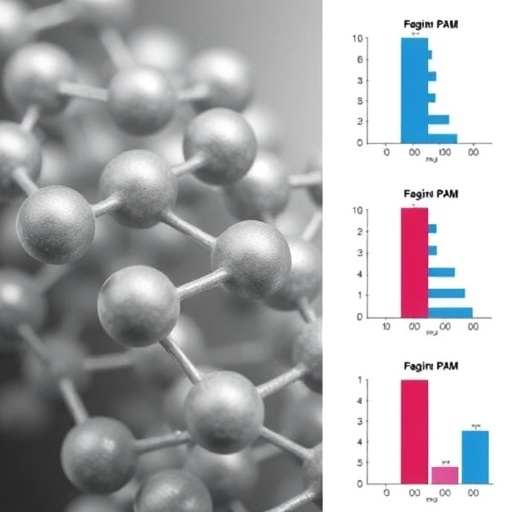A groundbreaking study published in the Journal of Translational Medicine has unveiled a promising new direction for the treatment of type 2 diabetes through a detailed examination of the multifunctional protein PAM, or Phorbol-12-myristate-13-acetate-induced protein 1. In this comprehensive exploration, researchers Yi, Feng, Guan, and their colleagues utilized advanced multi-omics technologies combined with Mendelian randomization frameworks to identify PAM as a potential therapeutic target. This research not only highlights the significance of PAM in metabolic regulation but also emphasizes the importance of integrating various biological data sources to elucidate complex disease mechanisms.
Type 2 diabetes continues to pose a significant global health challenge, affecting millions and contributing to various comorbidities, including cardiovascular diseases and renal complications. Current treatment modalities primarily target glucose control, yet emerging evidence suggests that addressing underlying biological pathways may yield more effective therapeutic strategies. The present study’s melding of genetics, proteomics, transcriptomics, and metabolomics offers a multifaceted approach that is essential for advancing precision medicine in diabetes management.
Mendelian randomization has emerged as a powerful tool to infer causal relationships between exposures and disease outcomes by leveraging genetic variants as instrumental variables. Traditional epidemiological methods may be confounded by environmental factors and reverse causation. However, the use of genetic variations aids researchers in overcoming these biases, providing a robust foundation for establishing causal inferences regarding the influence of PAM on type 2 diabetes.
In their investigation, the research team conducted an extensive multi-omics analysis, integrating data from genomic, transcriptomic, and proteomic sources. This strategy allowed them to capture a comprehensive picture of biological interactions and identify specific pathways influenced by PAM. The findings indicate that PAM is not only integral to glucose homeostasis but also influences lipid metabolism, making it a critical player in the pathophysiology of type 2 diabetes.
The implications of the study extend beyond merely highlighting PAM as a target; they also underscore the functional consequences of PAM modulation. In cell culture experiments, decreased PAM expression resulted in impaired insulin signaling, ultimately leading to decreased glucose uptake in response to insulin stimulation. This cellular dysregulation can contribute to the insulin resistance commonly observed in individuals with type 2 diabetes and highlights the potential for PAM-targeted therapies to restore proper metabolic function.
Moreover, the exploration of PAM’s role in lipid metabolism adds an exciting dimension to understanding diabetes. The study observed that altered PAM levels were associated with significant changes in lipid profiles, including elevated triglycerides and reduced high-density lipoprotein (HDL) levels. These lipid abnormalities are often seen in type 2 diabetes and contribute to increased cardiovascular risk, further establishing PAM’s relevance as a multi-faceted regulator of metabolic health.
In addition to their laboratory findings, the researchers validated their hypotheses using large-scale genomic datasets, reinforcing the significance of PAM as a therapeutic target. This validation enhances the credibility of their conclusions and paves the way for future clinical trials aimed at developing PAM-targeted interventions for diabetes management. Harnessing the power of multi-omics may catalyze new therapeutic avenues, ultimately shifting the paradigm toward more effective diabetes treatments.
As the field of diabetes research progresses, a comprehensive understanding of the molecular mechanisms underpinning disease development becomes imperative. The ability to identify and validate specific protein targets like PAM not only provides insight into disease pathogenesis but also fosters innovative therapeutic strategies. With the rise of personalized medicine, the identification of PAM could enable more tailored interventions based upon individual genetic profiles, thus maximizing therapeutic efficacy and minimizing adverse effects.
Despite the compelling findings of this research, challenges remain in translating these discoveries into clinical practice. Future research must address the complexities of PAM’s functions within various biological contexts, as well as the pharmacodynamics of potential PAM-targeted therapies. Addressing these aspects will be crucial for ensuring the safe and effective integration of PAM modulation into existing diabetes treatment regimens.
Moreover, the significance of public health implications cannot be understated. Successfully targeting PAM could revolutionize the way type 2 diabetes is treated, potentially reducing the burden on healthcare systems globally. The findings underscore the urgency of continued investment in translational research that bridges the gap between molecular discoveries and patient care, promoting a comprehensive approach to diabetes management that includes preventative measures through lifestyle modifications and advanced therapeutic interventions.
In summary, the study conducted by Yi et al. represents a significant advancement in our understanding of type 2 diabetes pathophysiology and highlights PAM as a promising therapeutic target. By employing multi-omics and Mendelian randomization, the researchers have set a precedent for integrating complex biological data in disease research. As the scientific community builds upon these findings, there is hope that the identification and modulation of PAM could lead to innovative and effective therapies, ultimately improving outcomes for millions affected by type 2 diabetes worldwide.
Through this innovative research, the potential for a paradigm shift in diabetes management becomes apparent, narrowing the focus on specific molecular targets while underscoring the importance of interdisciplinary approaches in tackling chronic diseases. This holistic strategy will ultimately enhance our understanding of metabolic disorders and lead to more successful interventions, fulfilling the need for more effective and personalized diabetes care.
In conclusion, the identification of PAM as a potential therapeutic target opens a new chapter in the fight against type 2 diabetes. As researchers continue to unravel the complexities of metabolic diseases through integrated scientific approaches, they pave the way for revolutionary advancements in treatment that may significantly alter the trajectory of this global health crisis.
Subject of Research: PAM as a therapeutic target for type 2 diabetes
Article Title: A multi-omics Mendelian randomization study reveals PAM as a potential therapeutic target for type 2 diabetes
Article References:
Yi, M., Feng, X., Guan, Q. et al. A multi-omics Mendelian randomization study reveals PAM as a potential therapeutic target for type 2 diabetes.
J Transl Med 23, 1067 (2025). https://doi.org/10.1186/s12967-025-07086-x
Image Credits: AI Generated
DOI: 10.1186/s12967-025-07086-x
Keywords: PAM, type 2 diabetes, Mendelian randomization, multi-omics, therapeutic target




